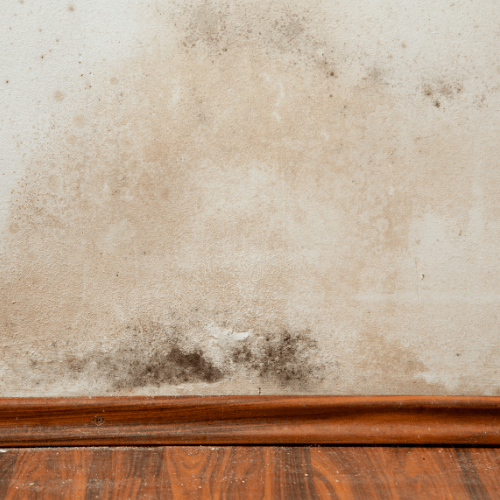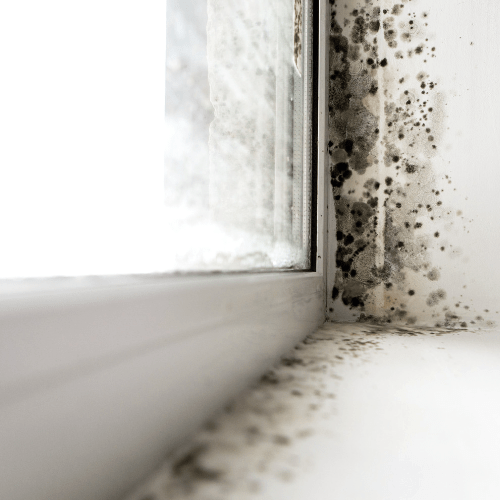
Damp Proofing
We look at Damp Proofing in a Building when issues arise. We provide solutions in each of these cases.
Radon Gas Control | Rising Damp | Falling Damp | Lateral Damp | Condensation/Mould Control/Cold Bridging

Radon Gas Control
Radon is a naturally occurring radioactive gas that originates from the decay of uranium in rocks and soils.
Since July 1998, revised building regulations see all new dwellings and buildings required to incorporate some degree of radon preventative measures at the time of construction. The degree of protection required is dependent upon whether the site is located within a high or low radon area.
Radon gas prevention membranes also act as a damp proof membrane, preventing ground vapour from entering a building.
RADON PREVENTION SERVICES
Protecting new buildings from radon and ground gases ensures health protection for generations to come
- This Treatment includes a specification & design service.
- This Treatment is carried out as an approved contractor.
- This Treatment Comes with A Certificate of Compliance to Building Regulations.

Rising Damp
Rising damp occurs when the lower regions of walls are affected by damp from the ground rising by capillary action.
In a modern building, a watertight damp proof course is placed in block work at a low level, which serves as a barrier against upwardly moving ground dampness. In earlier times, rising ground dampness and its effects were not well known, and with the exception of very far sighted practice, old stone and brick walls were not provided with a damp-proof course.
The end result is that the affected walls are permanently damp at a low-level, being visibly affected in the form of damp staining of decorations, breakdown of plaster, deterioration of skirting timbers, window panelling timbers and doorframes.
We provide the two main systems by which rising damp is eliminated:- Siliconate Or Liquid Chemicure Injection Damp Proof Course
- Electro-Osmotic Damp-Proof System.
However, prior to committing to remedial damp proof treatments, with associated disruption and expenditure, it is essential that the actual cause of low-level dampness is established. Other factors could contribute; such as pipe leaks, incorrect level of damp proof course, defective floor, or high external ground levels.
If a building does indeed have rising damp, you would expect to see some or all of these issues:RISING DAMP SERVICES
Rising damp treatments are a quick and effective way of relieving walls and timbers of excess ground moisture.
- Treatments are Usually Complete in One Day.
- The Silicone Microemulsion Is Water Based, Low Odour, Non-Hazardous and solvent free.
- This treatment is carried out as an approved contractor.
- This Treatment Comes with A Ten Year Guarantee.

Falling Damp
Commonly associated with roofs, falling damp refers to dampness travelling vertically downward caused by moisture entering the building from above. It is almost exclusively caused by structural defects and poor maintenance.
A common area affected by falling damp is chimneys stacks. Where pointing, render and flashings have been fitted incorrectly or indeed just worn down over time, we can see damp staining on the chimney breast internally.
Falling damp in an attic space can also lead to issues with condensation. Attic spaces are typically humid areas; the perfect environment for mould spores to germinate and spread.FALLING DAMP SERVICES
Falling damp treatments are an effective long term solution to damp ingress from above.
- This treatment comes with a specification and design service
- This treatment comes with fully qualified lime plasterers
- This treatment comes with over 60 years combined lime pointing & rendering experience

Lateral Damp
Also, commonly referred to as penetrating damp, Lateral damp is when groundwater penetrates sideways into a property. It can affect any floor that is in contact with soil or has a higher external ground than internal floor level.
Buildings on sloped ground are more vulnerable, as the slow flow of groundwater downhill puts additional hydroscopic pressure on walls.
Lateral damp causes more problems than just an unpleasant odours, it can also lead to structural issues for walls which the entire building is relying on for support.
Lateral damp can be exasperated if hygroscopic salts contaminate the walls. These salts are constantly absorbing moisture from the air, which can rapidly accelerate a damp problem.
The increase in moisture content in the air can also lead to increased condensation and mould with all the associated health problems they cause.LATERAL DAMP SERVICES
Lateral damp treatments are an effective way of relieving walls and timbers of excess moisture.
- This treatment comes with a specification and design service
- This treatment is carried out as an approved contractor.
- This Treatment Comes with A Ten Year Guarantee.

Condensation / Mould Control / Cold Bridging
Condensation, mould and cold bridging are three problems that are commonly found together. In a sense, they spur each other on! It is important to consider all three when creating a solution.
The issue usually begins with condensation, which is amplified by cold bridging and both then lead to the presence of mould.
So, let’s start with Condensation.
Condensation is caused when moisture-laden air comes into contact with a cold surface –the air is cooled to a point where it can no longer hold its burden of water vapour. At this point, dewpoint, water begins to drop out of the air, and it is seen as condensation on surfaces.
Cold Bridging, also known as thermal bridging, is quite simply a gap in insulation. Such bridges are commonly found at junctions of a building i.e. wall to floor, window to wall.
Cold bridging is very common in older buildings where an emphasis on energy efficiency and air tightness wasn’t common place.
We can see that if cold bridging is likely to occur around a window and condensation is likely to fall on the glass, these two features are likely to lead to mould spores germinating and multiplying.
The positive outlook with these issues is there are many things that can be carried out by the building owner / occupier to alleviate the issues in the short term.Get in Touch
If you would like to know more about these our Damp Proofing Services, please contact us. You can contact us here, by phone at 087 1192740 or by email at info@ffcr.ie. We look forward to hearing from you!

FF Conservation and Restoration blends traditional building methods with new conservation technologies. We work on projects
large and small helping Ireland's built heritage meet the modern day requirements of buildings today.
Services
Completed Projects
Office
11 Blakes Glen, Curracloe, Enniscorthy,
Co. Wexford,
Y21 RC43.
Fintan
info@








